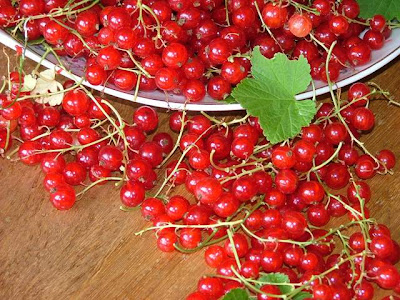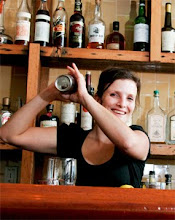
As a pretty geeky bartender, I like to scan old bar books looking for drink recipes that call for obscure ingredients (see Capillaire and Orchard Syrup).
I first came across Sirop-de-Groseille in the Savoy Cocktail Book, although it's also listed in Harry McElhone's "Barflies and Cocktails." It's a red currant syrup, sometimes used as a substitute for grenadine or raspberry syrup. It's often described as having a similar flavor to those, although I find it quite different, tannic and with an odd seedlike flavor, like biting into an apple seed. I think it is this quality that makes it a good match with kirsch, as kirsch is made by fermenting whole sour cherries including their pits.
Stone fruit seeds and apple seeds contain benzaldehyde, a poison related to cyanide (see The Trouble With Cyanide). The flavor is barely noticeable in fresh red currants, but when I cooked it into a syrup, the seedlike pungency is much more pronounced.
The first recipe I saw with this syrup was the Artist's Special from the Savoy. I always like drinks that combine sherry with another liquor, and the nutty oxidation of the sherry tones down the tannins and seedy flavor of the groseille. Erik Ellestad of Underhill-Lounge describes his experience with this cocktail here.
Artist's Special Cocktail
1 oz whisky
1 oz sherry
1/2 oz lemon juice
1/2 oz groseille syrup
Shake and strain into a chilled cocktail glass.
CocktailDB lists the Nineteen-Twenty, a cocktail with both groseille and kirsch. I love this combination, and I love this drink, although I prefer a variation made with genever instead of gin. My co-worker Jon suggested this as I was working out the drink, and I think it is just fabulous.
Dutch 20
1 1/2 oz dry vermouth
3/4 oz genever
1/4 oz kirsch
1/4 oz sirop-de-groseille
Stir and strain into a chilled cocktail glass. Garnish with a lemon twist.
There is a French cocktail called The Rose, published in "Petits et Grands Verres" from 1927 that is essentially this drink without the gin. The name refers to the color the syrup lends the drink.
CocktailDB also lists a recipe for making the syrup:
Express the juice of small red currants, reds. Per quart of juice obtained, add 2 quarts of water and 3-1/2 lbs. of sugar. Dissolve sugar in water before adding the juice. Leave standing for several days. Filter or clarify and bottle.
I suppose you could put the currants through a juicer, but I find it easier to simmer them in water for about 10 minutes until the water is bright pink and the fruit looks anemic and sad. Press the whole mass through a chinois. You don't need to de-stem the currants, either, just throw everything into the pot. And I don't know why you would let it stand for several days, except to eliminate solids. I am far too impatient, so I let the whole mass drip slowly through a jelly bag. It still had a tiny amount of sediment, but not enough to be noticeable in a drink.
In any case, red currants are only available fresh for a short period of time every year. But the syrup will last for a while, so give it a try! Or come into Heaven's Dog, for as long as my bottle lasts, of course.

7 comments:
Wow cool...I too have seen it pop up in the Savoy manual and usually pass over those drinks but I saw red currants at the framers market last week and I think I'll give it a whirl. How does the flavor compare to real grenadine? Do you it could be used instead in most cases? I just got finished making passion fruit and kiwi syrups and vanilla tobacco is next on my list
I actually think it tastes more like fake grenadine. Real grenadine, as I make it anyway, is very rich and pomegranate-y, and the groseille is more red fruit flavored and floral. If you are using commercial grenadine, then yes, this will beat the pants off it. But I don't see it as a substitute for actual pomegranate grenadine.
Your passion fruit syrup sounds delicious! Are you local?
If local is NYC then yes, I'm local. Where are you? I used to use Fee's grenadine and then the middle eastern pomegranate molasses but no I slow boil my own and preserve it with grain spirit. Check out my blog if you get a chance I think you'd like it.
www.boozeburgersandbeats.com
it's a little nyc centric but there's some good cocktail stuff buried in it.
I'm going to link up to your blog
I love what you're doing so I hate to nerd out on you, but benzaldehyde and cyanide aren't related. They merely smell the same.
Hi jps,
I love nerding out!
While benzaldehyde and cyanide are not the same, they are related by association. Apple and stone fruit seeds contain amygdalin, a glycoside which breaks down under enzyme catalysis into glucose, benzaldehyde and hydrogen cyanide. The cyanide smells faintly of bitter almond and the benzaldehyde smells strongly of the same, which is why it is used in bitter almond extract (in the U.S. it is usually just called almond extract). This is why eating a lot of bitter almonds can be hazardous to your health, and why they are illegal to import, but almond extract is safe and widely available.
Take care,
Jennifer
There is a great drink out there that I discovered in France this summer which calls for groseille syrup (also called cassis in France for the village it comes from):
Kir
In a flute glass, pour white wine of choice and top off with groseille syrup.
Kir Royal
Same as above, but switch white wine with champagne.
I prefer the latter, but enjoy!
I love a Kir or a Kir Royale!
A Kir is traditionally made from aligote, the other white grape of Burgundy (other than Chardonnay). It is crisp and bracingly dry, and rarely found outside of France. But if you can find it, it makes a delicious Kir. Here, people tend to mix cassis with any dry white, although it has been my experience that most whites available domestically are too fruity to be mixed with liqueur, and the drink ends up tasting somewhat flabby.
Kir and Kir Royale are made with Creme de Cassis, a liqueur made from black currants, rather than sirop de groseille, which is made from red currants and not alcoholic. The French, eh? They have a different word for everything.
Note: the "Creme" in Creme de Cassis and all those other "Creme de -" liqueurs refers to the sugar level being high enough that the viscosity of the product is that of cream, not that there is actually cream in the stuff.
Post a Comment